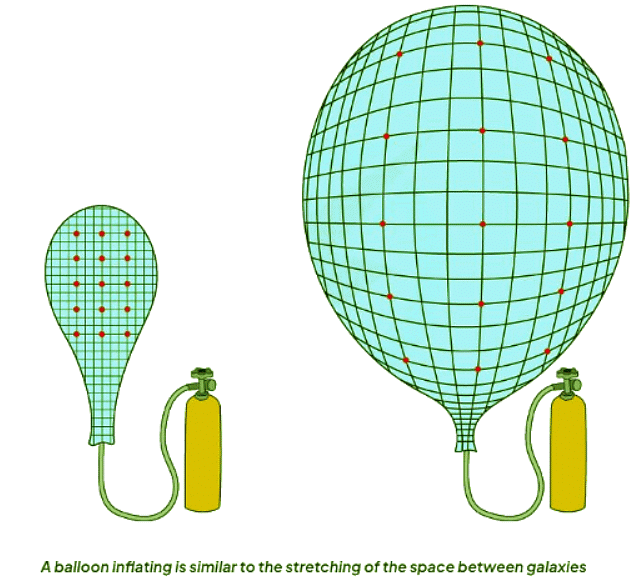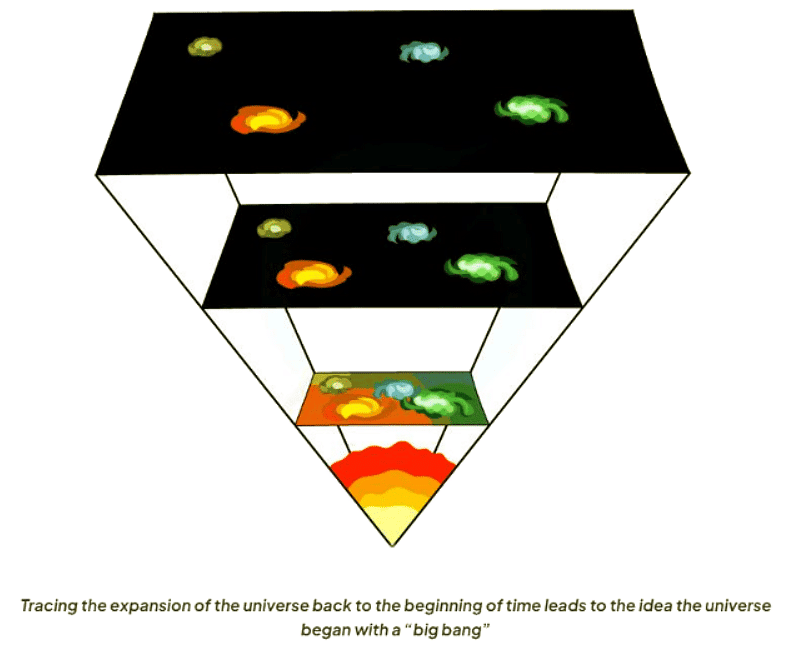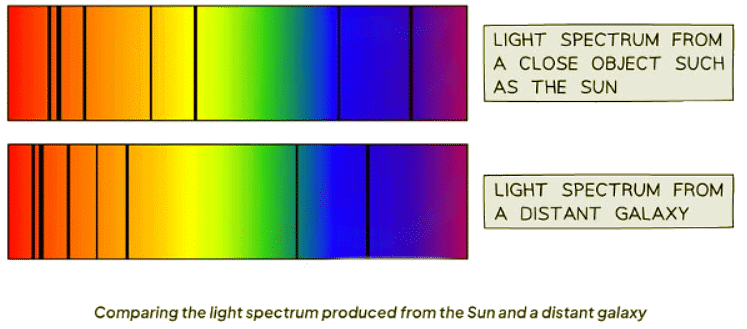Year 11 Exam > Year 11 Notes > Physics for GCSE/IGCSE > The Big Bang Theory
The Big Bang Theory | Physics for GCSE/IGCSE - Year 11 PDF Download
Big Bang Theory
- Around 14 billion years ago, the Universe originated from an extremely hot and dense small region.
- Subsequently, a colossal explosion ensued, famously known as the Big Bang.
- This event triggered the expansion of the universe from a singular point, gradually cooling down to its current state.
- Each point within the universe moves apart from the others, illustrated by galaxies drifting away. The farther they are, the more rapid their motion.
- The redshift observed in light from distant galaxies serves as evidence supporting the expanding universe theory that aligns with the Big Bang Theory.
- As a consequence of the initial explosion, the Universe perpetually expands.
Expansion of the Universe
- One way we observe the expansion of the universe is through galaxies moving away from each other. The farther apart they are, the faster they move.
- Redshift in the light from distant galaxies provides evidence supporting the Big Bang Theory. This shift indicates the universe's expansion following the initial explosion.
- Imagine a deflated balloon with points representing galaxies. When the balloon expands, these points move further apart, just like galaxies in the universe. The space between galaxies expands similarly.

Redshift and CMBR
Evidence for the Big Bang
- The Big Bang theory is strongly supported by evidence from various sources.
- The primary evidence includes Galactic red-shift and Cosmic Microwave Background Radiation (CMBR).
Galactic Redshift and the Expansion of the Universe
- Galactic redshift serves as evidence supporting the Big Bang Theory and the ongoing expansion of the universe.
- The concept can be visualized through the light received from nearby objects like the Sun contrasted with light from distant galaxies.
Significance of Redshift in Cosmic Expansion
- Red-shift, exemplified by the movement of spectral lines towards the red part of the spectrum, offers crucial evidence for the universe's expansion.
- The stretching of light waves due to the universe's expansion results in longer wavelengths or lower frequencies.
- This observable phenomenon reinforces the idea that galaxies are receding from each other and from us.
Understanding Redshift in Galaxies
- When we observe galaxies in the universe, we notice that light waves from them are stretched due to the expansion of the universe. This stretching leads to an increase in wavelength or a decrease in frequency, indicating that the galaxies are moving away from us.
- This stretching of light waves, or redshift, suggests that galaxies are moving away from us.
Redshift and Distance Relationship
- Light spectra from galaxies that are far away exhibit more redshift compared to nearby galaxies. This redshift increases with the distance to the galaxy, meaning that the farther a galaxy is, the faster it is moving away from the Earth.
- The greater the distance to a galaxy, the greater the redshift observed in its light spectrum.
- This indicates that galaxies that are further away from us are receding at a faster rate.
Expanding Universe and the Big Bang Theory
- Scientists have observed that the universe is expanding, providing crucial support for the Big Bang Theory.
Implications of the Expansion
- The expanding universe indicates that galaxies are moving away from each other over time.
- This expansion suggests that the universe originated from a single point in a massive explosion, commonly known as the Big Bang.

Discovery of Cosmic Microwave Background (CMB) Radiation
- The detection of Cosmic Microwave Background (CMB) radiation significantly bolstered the credibility of the Big Bang theory as the prevailing cosmological model.
Nature of CMB Radiation
- Cosmic Microwave Background (CMB) radiation is a form of electromagnetic radiation remaining from the early epochs of the Universe.
- This radiation, with a wavelength of approximately 1 mm, falls within the microwave range, hence earning the name Cosmic Microwave Background radiation.
Discovery of Cosmic Microwave Background Radiation
- In 1964, astronomers made a groundbreaking discovery in the microwave region of the electromagnetic spectrum.
- This radiation was observed emanating uniformly from all directions, exhibiting a consistent temperature of 2.73 K.
- Previously, detecting these microwaves was challenging due to atmospheric absorption.
Challenges Faced by Astronomers
- Astronomers encountered difficulties in detecting cosmic microwave background radiation earlier due to atmospheric interference.
Significance of Space Flight Development
- The evolution of space flight technology was pivotal as it facilitated the deployment of telescopes beyond the atmospheric barrier.
The Big Bang Theory
- According to the Big Bang theory, the early Universe existed in an intensely hot and dense state.
- The Universe emitted thermal radiation as a consequence of its early conditions.
- This thermal radiation is now observed in the microwave region.
- Over approximately 14 billion years, radiation from the Big Bang has undergone redshift due to the expansion of the Universe.
- Initially high-energy radiation has transitioned to the microwave region as the Universe expanded.
- The wavelength of radiation increased as the Universe expanded, ultimately reaching the microwave spectrum.

- The Cosmic Microwave Background (CMB) radiation exhibits remarkable uniformity and matches the expected emission profile of a hot body that has cooled over an extensive period.
- This characteristic poses a challenge for alternative theories like the Steady State Theory, which fail to account for such consistency.
- The CMB is visualized through a map:

The Observable Universe
- This is the closest representation resembling a map of the observable Universe.
- The colors used in the image indicate varying temperatures:
- The red, orange, and brown regions signify warmer temperatures, suggesting a higher density of galaxies.
- The blue regions denote cooler temperatures, indicating a lower density of galaxies.
- The temperature of the Cosmic Microwave Background (CMB) radiation is predominantly uniform. However, there are minute temperature fluctuations, approximately 0.00001 Kelvin in magnitude.
- This uniformity implies that the objects within the Universe are distributed rather evenly.
Question for The Big Bang TheoryTry yourself: What is the main evidence supporting the Big Bang Theory?View Solution
Measuring Galactic Speed & Distance
- By observing the change in wavelength of starlight from galaxies, known as redshift, scientists can determine the velocity (v) at which a galaxy or distant object is moving away from Earth. This is calculated by comparing the expected wavelength to the observed wavelength.
- Redshift analysis involves using an equation that compares the expected and observed wavelengths of light to derive the velocity of the object.
 This equation, though not directly tested, is crucial. It signifies that the velocity of distant objects can be inferred from the redshift observed in their wavelengths, a fundamental concept in astrophysics.
This equation, though not directly tested, is crucial. It signifies that the velocity of distant objects can be inferred from the redshift observed in their wavelengths, a fundamental concept in astrophysics.
Measuring Distance Using Supernovae
- Redshift and Cosmic Microwave Background (CMB) radiation enable accurate measurements of the Universe.
- Distance measurements utilize various methods.
Standard Candles and Supernovae
- Standard candles, like supernovae, play a crucial role in measuring distances.
- Supernovae, as exploding stars, provide a consistent peak brightness (absolute magnitude), aiding in distant measurements.
- Type 1a supernovae, exceptionally bright, facilitate distance calculations to galaxies, even when deeply embedded within them.
The document The Big Bang Theory | Physics for GCSE/IGCSE - Year 11 is a part of the Year 11 Course Physics for GCSE/IGCSE.
All you need of Year 11 at this link: Year 11
|
127 videos|148 docs|35 tests
|
FAQs on The Big Bang Theory - Physics for GCSE/IGCSE - Year 11
| 1. How does redshift provide evidence for the Big Bang Theory? |  |
Ans. Redshift occurs when light from distant galaxies appears to have a longer wavelength, indicating that the galaxies are moving away from us. This phenomenon supports the idea that the universe is expanding, which is a key component of the Big Bang Theory.
| 2. What is CMBR and how does it relate to the Big Bang Theory? |  |
Ans. CMBR stands for Cosmic Microwave Background Radiation, which is leftover radiation from the early universe. The existence of CMBR provides strong evidence for the Big Bang Theory as it supports the idea of a hot, dense beginning of the universe.
| 3. How do scientists measure the speed and distance of galaxies in the universe? |  |
Ans. Scientists use various methods such as redshift, luminosity distance, and standard candles to measure the speed and distance of galaxies. Redshift helps determine the velocity of galaxies, while luminosity distance and standard candles help calculate their distance from Earth.
| 4. What role does the redshift of galaxies play in determining the expansion of the universe? |  |
Ans. The redshift of galaxies indicates that they are moving away from us, and the extent of their redshift can be used to determine the rate of expansion of the universe. The higher the redshift, the faster the galaxy is moving away, suggesting a faster expansion rate.
| 5. How does the study of galactic speed and distance contribute to our understanding of the Big Bang Theory? |  |
Ans. By measuring the speed and distance of galaxies, scientists can further validate the Big Bang Theory by demonstrating the expansion of the universe and providing evidence of an initial hot, dense state. This data helps refine our understanding of the universe's origins and evolution.

|
Explore Courses for Year 11 exam
|

|
Signup for Free!
Signup to see your scores go up within 7 days! Learn & Practice with 1000+ FREE Notes, Videos & Tests.
Related Searches



 This equation, though not directly tested, is crucial. It signifies that the velocity of distant objects can be inferred from the redshift observed in their wavelengths, a fundamental concept in astrophysics.
This equation, though not directly tested, is crucial. It signifies that the velocity of distant objects can be inferred from the redshift observed in their wavelengths, a fundamental concept in astrophysics.















